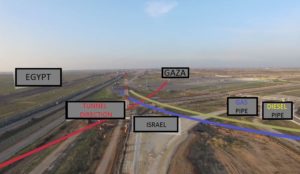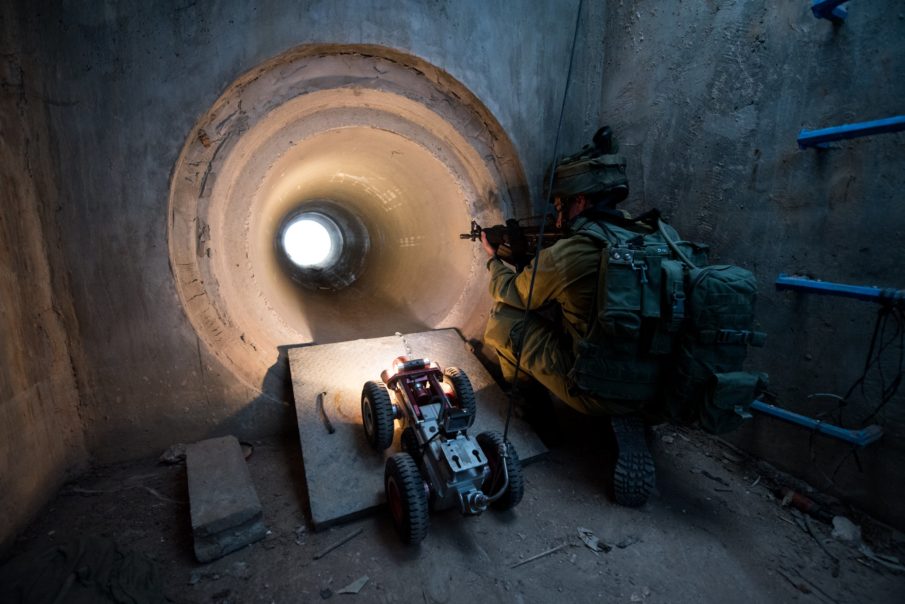The Israeli Airstrike on Saturday, Jan. 13, managed to successfully compromise what we in the IDF describe as an “offensive” or “terror” tunnel, since it is often being used to deploy small units behind enemy lines, or to pack the tunnel with explosives and blow it up below FOBs. This happened in 2004 when a tunnel packed with explosives was detonated below an Israeli FOB (“ORCHAN”) which resulted in a total destruction of the FOB and one KIA.
According to IDF’s spokesman, the tunnel — which was still in construction — was “primarily” attacked on the Gaza strip side, after it passed 180 meters into the Israeli side and eventually into the Egyptian side. The spokesman also noted that the total length of the tunnel was more than 1.5 kilometers long. This Israeli countermeasure against Hamas’ second-most valuable subsurface doctrine, marks the third successful attack by the Israelis on terror tunnels on its south-western borderline with Gaza. It is important to note that two of those tunnels were affiliated with Hamas, while only one was associated with the Islamic Jihad.
The tunnel originated all the way from Rafah, a Palestinian city and refugee camp in the southern Gaza Strip, and ended just past the Egyptian border. It passed below the Kerem Shalom border crossing, which serves as a hub on the Gaza Strip/Israeli border managed by the Israel Airports Authority. The crossing is used by trucks carrying goods from Israel to the Gaza Strip, including commercial or humanitarian aid supplies. Since December 2012, Israel eased its restrictions on the import of building materials (which ironically was blamed as what enabled Hamas to build so many tunnels in Operation Cast Lead), allowing the transfer of 20 truckloads of aggregates and 34 truckloads of gravel from Egypt. The volume is expected to increase to 100 trucks a day. In addition to the border crossing center, there are diesel and gas pipes delivering the much-needed energy to the strip.

Opinions of the author:
According to the IDF, the tunnel passed just below a border crossing facility, and right under the energy pipes — resulting in a very dangerous situation which could not (like in other cases) be ignored. The increasing precision in hunting and eliminating tunnels since last year (2017) should indicate that:
- Israel has solid situational awareness when it comes to these tunnels and their surroundings. This will likely cause some fingers to point at the Egyptian neighbors, who in return receive quality intelligence and perhaps even ISR from the Israelis in their bloody campaign against ISIS in Sinai.
- The successful and constant exposure of those high value tactical tunnels might suggest that the Israelis have developed an underground counter-tunnel system, similar to the famous “Iron Dome.” If that is the case, Hamas is losing its second most valuable tactical and strategical weight after its arsenal of rockets.
- There might be a need to develop or find an alternative smuggling route/solutions into the Gaza Strip, since most of the smuggling operations of weapons and building material originates from Sinai.
The latest developments probably remind Hamas of the slow, tightening grip of the Israeli-Egyptian siege of interests on its boundaries. How will Hamas react to this realization that their legitimacy in the strip and West Bank is once again threatened by the Zionist enemy?
Three things that may occur:
- The first and less likely: in the short-term, Hamas announces their agreement or participation in the Egyptian peace initiative between Fatah & the Palestinian National Authority in Ramallah in the West Bank. Such a move is unlikely to happen because one in Hamas wants to give control or influence to Mahmoud Abbas.
- They may open fire with rocket attacks against Israel, or alternatively its troops on the southern borders — a move that will be hard for Hamas to justify, since technically Israel attacked an asset which was violating its own space and putting at risk its humanitarian affairs with Gaza, granting Israel in return any right to prevent such attacks.
- Accept the situation and rethink their strategy or tactical means against Israel. Personally, I believe this is where Hamas will put pressure on Hezbollah and Iran to assist, finding new routes to smuggle from or methods to counter Israeli/Egypt intelligence collection in Sinai.
Already have an account? Sign In
Two ways to continue to read this article.
Subscribe
$1.99
every 4 weeks
- Unlimited access to all articles
- Support independent journalism
- Ad-free reading experience
Subscribe Now
Recurring Monthly. Cancel Anytime.












COMMENTS
You must become a subscriber or login to view or post comments on this article.